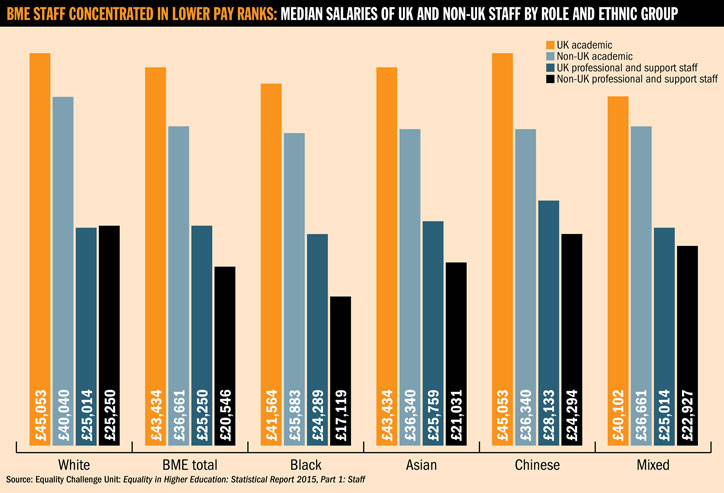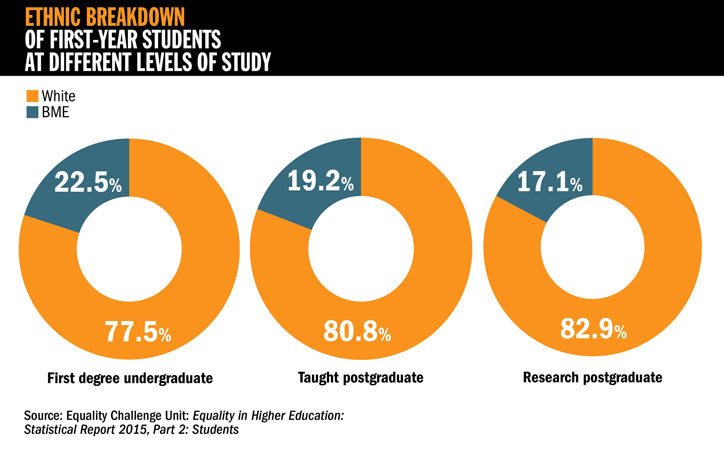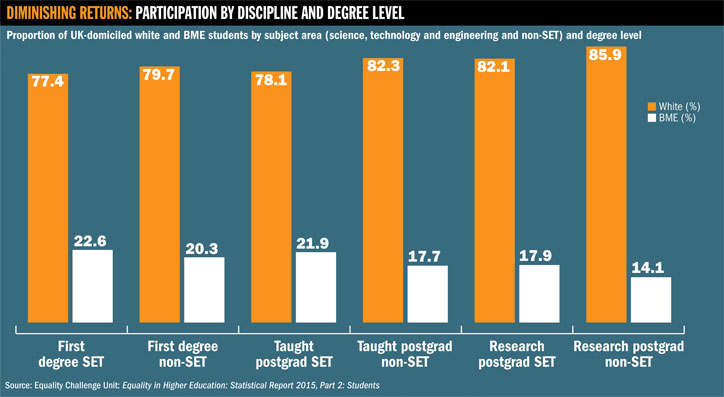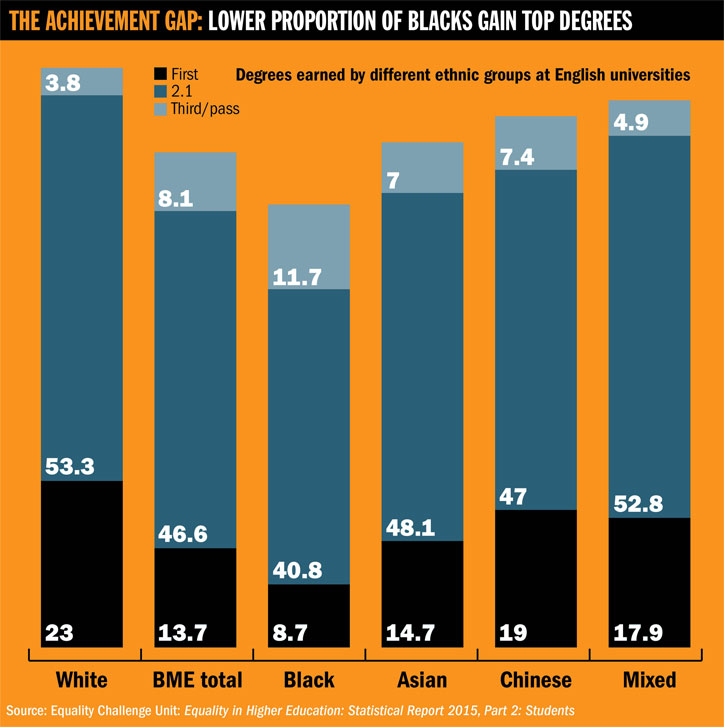When Baroness Amos began work as the new director of Soas, University of London in September, it was a landmark moment for UK higher education.
For the first time, a black woman was in charge of a university. In fact, Amos is the country’s first black vice-chancellor full stop.
But rather than being a cause for self-congratulation, her arrival at the top of the Bloomsbury institution – which is proud of its ethnically diverse student and staff body – serves only to highlight the difficulties that black and minority ethnic (BME) staff continue to face in their efforts to rise through the academic hierarchy.
Amos, a former Labour Cabinet minister, diplomat and United Nations ambassador, does not come from an academic background. The only two other BME vice-chancellors in the UK sector have also arrived at the top without passing through the traditional “academic pipeline” that produces most university heads. Gerald Pillay, vice-chancellor of Liverpool Hope University, is a South African-born theology scholar of Indian descent, who arrived in the UK in 2003 after teaching in New Zealand. Rama Thirunamachandran, vice-chancellor and principal of Canterbury Christ Church University since 2013, who is of Sri Lankan heritage, is a product of the UK system, but he really made his name as director of research, innovation and skills at the Higher Education Funding Council for England, before heading to Keele University as a pro vice-chancellor.
Looking at the Equality Challenge Unit’s latest study on staff numbers, to be published on 9 November, it is clear that ethnic minorities are under-represented in the senior ranks of university management. According to the report, Equality in Higher Education: Statistical Report 2015, there are just 20 UK-born BME deputy or pro vice-chancellors, compared with 530 white ones. Of course, there are fewer BME academics than there are white ones at all levels; according to the 2011 census, 86 per cent of the population of England and Wales is white, after all. But the ECU report notes that BME staff are half as likely as whites to hold one of those top roles. Overall, a significantly higher proportion of white university staff (8.5 per cent) than BME staff (6.4 per cent) are in senior roles. Among academics, the proportions in senior roles were 15.7 per cent for whites and 12.8 per cent for minorities.
Those statistics run counter to what has been an encouraging story of diversification in the lower academic ranks over recent years. The number of UK academic staff from a minority background grew by almost 80 per cent in a decade, up from nearly 6,000 staff in 2003-04 to almost 10,700 in 2013-14, the report says. Meanwhile, the number of non-UK BME academics rose at a similar rate, up from 7,050 in 2003-04 to 12,735 10 years later, but they are half as likely as non-UK white staff to be in senior roles.
“When it comes to bringing in [non-white] academic talent, the UK is fantastic,” observes the report’s author, Stephanie Neave, research and data manager at the ECU. “But senior staff [from ethnic backgrounds] are not coming through the UK system, so it would be good to have a discussion about why BME staff are so concentrated at much lower levels.”
That problem is illustrated in several other datasets in the ECU report. UK ethnic minority staff are concentrated more heavily in lower pay bands, leading to a median salary gap of £1,619 a year compared with their white counterparts. But that figure disguises wide disparities between different ethnic minorities: black academics are paid £3,489 less than the £45,053 median salary of white academics, but the gap disappears for Chinese staff and reverts to the BME average for Asians (see graph above).
Ethnic minority staff are also more likely to find themselves on a fixed-term contract, with 35 per cent employed on one, compared with 31 per cent of white staff. The gap was even larger for non-UK BME staff, of whom 50 per cent are on fixed-term contracts, compared with 41 per cent of white non-UK staff. It is, therefore, predictable that the rate of academics leaving their university is much higher for BME than for white staff, according to the ECU data: 21.7 per cent of BME academics left their institution between 2012-13 and 2013-14, compared with 15.7 per cent of white academics.
“I’m not surprised by this level of academic flight,” says Kalwant Bhopal, professor of education and social justice at the University of Southampton, who has interviewed ethnic minority staff about their frustrations with the academy.
“When [BME staff] pushed forward for promotion, they felt there was a higher threshold for them than [for] their white counterparts,” she says. “It is very covert, subtle and nuanced, but it amounts to the hierarchy seeking to reproduce itself in its own white, middle-class image.” White identity is “incredibly privileged and protected within academia”, Bhopal contends, stating that many top minority students are put off pursuing an academic career by the belief that their promotion prospects will be limited in white-dominated institutions.
Many of these concerns have been brought to the surface during discussions provoked by an event at University College London in March 2014, called “Why Isn’t My Professor Black?” The mainly minority audience asked why the UK’s diverse student population was not reflected in the ranks of university academics – particularly senior ones. One speaker commented that the only black faces employed by some universities are the security staff manning the entrances. The event was organised by Nathaniel Adam Tobias Coleman, who until recently was a research associate in the philosophy of race at UCL. Coleman claims that he was not offered a full-time job by the institution because his proposed MA course in black studies was deemed too critical of the white academic establishment (“Rejected MA was too critical of white establishment, says academic”, Times Higher Education, 21 May 2015).
The latest ECU data lay bare the extent of ethnic minority under-representation in the academy. Some 22.5 per cent of all first-year undergraduates are from ethnic minorities – although that falls to 19.2 per cent of first-year taught postgraduates and 17.1 per cent of first-year research postgraduates (see graphs, above). In comparison, the academic body was roughly three times as white as the first-year student cohort, with 8.2 per cent of academics and 7.3 per cent of professors identified as BME.
The drop-off between the undergraduate and the postgraduate level is particularly sharp among black students, who account for 7.3 per cent of first-year, first-degree undergraduates but only 3.6 per cent of starting research postgraduates. So why are relatively few black students making it through to higher study? According to Elizabeth Opara, associate professor in Kingston University’s Faculty of Science, Engineering and Computing, one major reason is lower average degree attainment by minority students, particularly black ones. According to the latest ECU data, 76 per cent of white undergraduates in England get a first or a 2:1, compared with 60 per cent of BME students overall – and just 50 per cent of black students. Nearly a quarter of white students (23 per cent) in England gain a first, but less than a tenth (9 per cent) of blacks do – a total of 1,595 in 2013-14 (see graph on page 39).
“A lot of black students are not getting good degrees – it’s a problem across the sector, from Russell Group institutions to post-92 universities,” Opara says. “You need to have a first – maybe a very good 2:1 – to do a PhD.” Adapting curricula to make them more inclusive and vibrant for a multicultural student body is one way to enthuse BME students and engage them in their studies, she says.
“People are very dismissive of this agenda – they will say ‘science is science’ if you suggest making changes. But when you are talking about groundbreaking research, many of the authors [of the papers highlighted] will be European[…] How often do people use academic papers from Africa or the Indian subcontinent?” she asks.
These types of changes could encourage minority ethnic students in the sciences (just under half of all BME students study a science, engineering or technology subject) to think of themselves as potential researchers, Opara says. “If you put yourself in their shoes, who do they see teaching them in the lab? They do not see people like themselves and may ask themselves if scientists are just middle-aged men – it may be hard to see an obvious route for them into a scientific career.”
But increasing the number of PhD students from minorities is not a solution in itself, says Winston Morgan, reader in toxicology and clinical biochemistry at the University of East London, noting that there is a “shocking” dropout rate among BME PhD students. While 17 per cent of those starting PhDs are non-white, just 12 per cent of doctorates are awarded to BME students, says Morgan, who has analysed data from the Higher Education Statistics Agency. One of the main reasons for this, he says, is that BME students may find it harder to form a strong bond with their PhD supervisors. “When you are doing a PhD, you are working so closely with a supervisor, but the identity group is so white,” Morgan says. Even those who get through may not cement that strong bond vital for securing glowing references or entry into the academic networks that can secure a first academic job, he adds.
Restricting research council funding of doctoral training programmes to a relatively small number of research-intensive institutions will also do little to help BME students, Morgan continues, “given that ethnic minority students are concentrated in post-92 universities”. He argues that his own post-92 university is better placed to support aspiring PhD students from non-traditional backgrounds than more illustrious institutions. “If you have a single mother who has a first and who wants a research career – and we do get them – it’s very hard to access a programme, so you need the right support, and my institution knows how to [deliver] that.”
Some might argue that the “broadening the talent pool” approach dodges the tricky question of why well-qualified minorities in the academy still find it so difficult to get ahead. A University and College Union report published in 2013 found that ethnic minority staff applying for academic jobs are less likely to be shortlisted for interviews and three times less likely than white candidates to be successful. The report, The Position of Women and BME Staff in Professorial Roles in UK HEIs, found that of those who applied for senior lecturer posts at 22 of the universities with the biggest gender and BME representation gaps, only 4 per cent of BME applicants were successful, compared with 12 per cent of white applicants. For professorial positions, the figures were 7 and 21 per cent respectively.
“Once you gain an academic job, you are not promoted [if you are not white]. And if you are, you get less of a chance to stay in your job,” Morgan says.
If that is true, why hasn’t more been done within institutions to tackle these problems – particularly given the emphasis on addressing gender inequality through initiatives such as the ECU’s Athena SWAN awards?
“If you accuse an institution of sexism, it’s something it will take on the chin and it will examine the claim,” says Morgan. “If [it is] accused of racism, which is linked to slavery and other awful things, people won’t accept it and no one will talk about it.”
But things may be about to change. At the end of October, prime minister David Cameron announced that Ucas will make university applications “name-blind” from 2017, to minimise unconscious bias against BME applicants.
This issue is also to be addressed by the ECU’s Race Equality Charter scheme, whose first eight winners were named in August after a year-long pilot. Under the scheme, institutions will be asked to analyse the diversity of their student and staff bodies, but also to investigate the disparities and to spell out what they are doing to remedy them. For instance, they may be asked to state how many ethnic minority staff they considered for promotion that year, what they are doing to encourage people to apply and what support those individuals are given throughout the process.
Deborah Gabriel, lecturer in politics, media and mass communications at Bournemouth University and founder of the Black British Academics group, welcomes the scheme, and believes that universities can make promotion processes fairer and more open to ethnic minority staff. She says that Bournemouth’s recent decision to open its staff development opportunities to all staff will benefit BME academics. “Those opportunities are sometimes only available to staff who are nominated by their line manager; so if there are cliques, then the old boy network can decide to exclude someone,” she explains.
“Taking academic career frameworks away from departments, so that promotions are judged by independent panels on clear criteria, is another good step.”
The race equality mark is still in its early days, and, like Athena SWAN, will be available only to subscribing institutions when the ECU moves to a subscription model from next January. But many believe it has great potential to propel more ethnic minority staff to the top of UK universities. “We’ve had 10 years of Athena SWAN, and we’re only just starting to see the effect,” says Bhopal. “It all sounds very simple, but I think [the Race Equality Charter] will be a springboard to help many more staff become readers, then professors and, who knows, even vice-chancellors.”
Melting pot: How representative is the US academy?
In the US, the latest official figures, from the autumn of 2013, reveal that 79 per cent of full-time faculty in degree-awarding institutions were white. Another 10 per cent were Asian or Pacific islanders, 6 per cent were black and 5 per cent were Hispanic.
The proportion of whites rises to 84 per cent among full-time professors, while the representation of minorities drops to 9 per cent for Asians and Pacific Islanders, 4 per cent for blacks and 3 per cent for Hispanics.
Black and minority ethnic (BME) academics were most prominent at assistant professor level, accounting for 24 per cent of the total body. However, their representation falls again at even more junior levels; only 18 per cent of lecturers, for example, are non‑white.
By way of comparison, the US Census Bureau says that whites made up 62 per cent of the overall US population in 2014. Hispanics made up 17 per cent, blacks 13 per cent and Asians and Pacific islanders 6 per cent.
Official figures on the racial background of college and university presidents are not available. However, according to a recent count by H. Patrick Swygert, the former president of Howard University in Washington DC, 29 African Americans currently serve as presidents of majority white colleges and universities, nearly all of which are public institutions. Another 114 black presidents serve at historically black colleges. There are about 3,000 post-secondary colleges and universities in the country, and the figures for black leaders have remained largely unchanged over the past 20 years, Swygert says.
According to a book published recently by Kalwant Bhopal, professor of education and social justice at the University of Southampton, the proportion of all degrees obtained by all BME students in the US increased in the first decade of the 21st century. For instance, the proportion of blacks among the earners of bachelor’s degrees rose from 9 per cent in 1999-2000 to 10.3 per cent in 2009‑10, and the proportion among doctoral graduates climbed from 6.4 per cent to 7.4 per cent.
The proportion of Hispanics rose from 6.3 to 8.8 per cent for bachelor’s degrees, and 4.7 to 5.8 per cent for doctorates. For Asians and Pacific islanders, the rises were 6.5 to 7.3 per cent for bachelor’s degrees and 10 to 11.8 per cent for doctorates, according to Bhopal’s book, The Experiences of Black and Minority Ethnic Academics: A Comparative Study of the Unequal Academy.
POSTSCRIPT:
Print headline: Mountains still to climb
Register to continue
Why register?
- Registration is free and only takes a moment
- Once registered, you can read 3 articles a month
- Sign up for our newsletter
Subscribe
Or subscribe for unlimited access to:
- Unlimited access to news, views, insights & reviews
- Digital editions
- Digital access to THE’s university and college rankings analysis
Already registered or a current subscriber? Login












